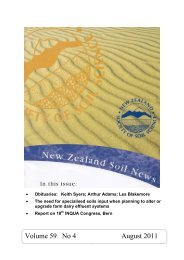Download - New Zealand Society of Soil Science
Download - New Zealand Society of Soil Science
Download - New Zealand Society of Soil Science
Create successful ePaper yourself
Turn your PDF publications into a flip-book with our unique Google optimized e-Paper software.
The following day began with rain, which got heavier as the day progressed. Between sites on the<br />
Waitaki fan the minivan had to ford a normally shallow and quiet irrigation channel. It was wider than<br />
usual but alas also deeper and the van full <strong>of</strong> overseas guests came to a sudden stop as the water<br />
rushed over and drowned the engine. Stranded in the middle <strong>of</strong> the race with water lapping around<br />
their feet, Elwyn and I piggy backed the visitors across the channel, and proceeded to dry out the<br />
ignition and get the engine running again. From this point on the day got progressively worse with<br />
loess sections almost invisible in the rain and the van suffering further misadventures; with a<br />
punctured rear tire and a spare with a gaping hole in it, a transmission that would not allow the gears<br />
to be changed between second and third and a clutch that wasn‘t keen to work. As a result a lot <strong>of</strong> faith<br />
was put on the brakes during the descent into Dunedin on a cold and miserable evening. It was<br />
Elwyn‘s good cheer that kept me the driver on track and the visitors calm and unaware <strong>of</strong> the drama<br />
that was unravelling.<br />
David Ives never did complete his ambition to be the principle loess investigator in Canterbury, with<br />
his energies redirected to other soil surveys allowing insufficient time to complete the studies he had<br />
intended. Studies that in all probability would have led on to his completion <strong>of</strong> a PhD. David resigned<br />
from <strong>Soil</strong> Bureau in 1975 to take up a position with ANZDEC <strong>New</strong> <strong>Zealand</strong> Limited as an<br />
international soil survey consultant.<br />
It is with a feeling <strong>of</strong> sadness that I acknowledge the death <strong>of</strong> Elwyn. I am fortunate to have known<br />
him and learned from him and to have shared time with him in the field.<br />
From Hugh Wilde.<br />
I first met Elwyn in early 1967, the year after he and his family arrived in NZ from Pakistan. I had<br />
recently started work as a soil scientist with Mike Leamy at the DSIR <strong>Soil</strong> Bureau Alexandra <strong>of</strong>fice,<br />
and the Griffiths were based in Christchurch. Elwyn was a frequent visitor to Central Otago.<br />
We both began our NZ careers about the same time – Elwyn with about 12 years work behind him in<br />
Africa and Pakistan, and me just out <strong>of</strong> university. What I remember <strong>of</strong> those early days were the long<br />
discussions about NZ soils and soil water issues, particularly those relating to irrigation problems.<br />
There were also discussions about departmental politics. It was no problem for Elwyn to hold a<br />
vigorous debate with several adversaries at once. He had formed his views <strong>of</strong> the world while growing<br />
up in a small village in post-war Wales, being conscripted into the British Army to serve during the<br />
Korean War as a 19 year old, and afterwards resuming his university studies and eventually work<br />
overseas in Rhodesia and Pakistan as a soil scientist. It came as no surprise to many <strong>of</strong> us that, given<br />
Elwyn‘s interrupted education through conscription and his experiences as a private soldier in Korea,<br />
he was vehemently anti war and anti military. Any mention <strong>of</strong> the military to Elwyn would invoke a<br />
very forceful response against incompetent management <strong>of</strong> any sort, but particularly military.<br />
In Canterbury, Elwyn worked on soil surveys in the Waikari District, the Lower Waitaki Glenavy<br />
Irrigation scheme, and also in Central Otago with work related to the planning <strong>of</strong> the proposed<br />
Maniatoto Irrigation scheme.<br />
In 1972, when the Christchurch <strong>of</strong>fice <strong>of</strong> <strong>Soil</strong> Bureau was relocating to Lincoln, Elwyn and his family<br />
moved to the Havelock North DSIR campus where he worked on soil surveys and soil-water issues in<br />
the wider Hawke‘s Bay area. I had already moved north to the Wanganui–Manawatu region and <strong>of</strong>ten<br />
arranged visits to Havelock North where my parents lived, to meet up with Elwyn and discuss<br />
technical issues <strong>of</strong> interest to us both.<br />
Elwyn would never shy away from a good argument. If the younger people had an issue either<br />
technical, or with the hierarchy, they could always share it with Elwyn and receive full support – or<br />
good advice on how to make it go away if the boss was right all along.<br />
I valued Elwyn as a colleague for nearly 30 years, particularly having the opportunity to work with<br />
him occasionally and to visit Elwyn and Jim Watt at Havelock North. The 1980‘s <strong>Soil</strong> Water<br />
Assessment and Measurement Programme (SWAMP) orchestrated by Elwyn and Jim is one example.<br />
158










